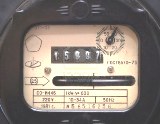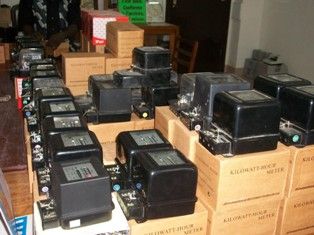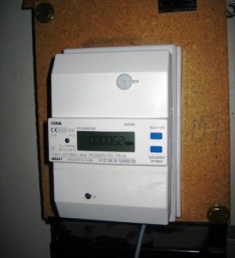Electricity meters
 Electricity meters are a variety of electricity meters that allow you to determine the consumption of consumed energy, both in production and in everyday life.
Electricity meters are a variety of electricity meters that allow you to determine the consumption of consumed energy, both in production and in everyday life.
The first devices for measuring electrical energy appeared at the end of the 19th century, when it was possible to turn electricity into a product of consumer demand. The standardization of measuring instruments developed in parallel with the improvement of lighting systems.
Currently, there are many devices for calculating electricity consumption, which are classified by the type of measured parameters, by the type of connection to the power grid, by the type of project.
According to the type of measured parameters, the electricity meters are single-phase and three-phase.
According to the type of connection to the electrical network, the devices are divided into measuring devices for direct connection to the network and connection through a transformer.
By design, there are induction meters - electromechanical, electronic and hybrid.
Induction meter as follows: the magnetic field of the coils acts on a light aluminum disk with eddy currents induced by the magnetic field of the coils. The number of disk revolutions is directly proportional to the amount of energy consumed.
Analog devices have many disadvantages and that is why they have been replaced by modern digital devices. Disadvantages of induction devices include: significant accounting errors, impossibility of remote reading, operation at the same speed, inconvenience in operation and installation.
A device in which current and voltage act on electronic elements and create pulses at the output, the number of which depends on the consumed electricity, are called electronic meters. Electricity metering with the help of such devices it is more convenient, more reliable, creates the impossibility of electricity theft and conditions for differentiated tariff reporting.
Hybrid devices are rarely used, which are devices of a mixed type with an inductive or electronic measuring part, with a mechanical computing device.

Electricity metering rules are determined by the contractual relationship between the supplier and the consumer and take into account the interests of both parties.
The requirements for devices that calculate the consumed electricity are multifaceted and must ensure the accuracy and reliability of electricity consumption, availability and openness of measurements not only during its consumption, but also during production, distribution and transmission. All these provisions are reflected in state legislation.
For example, the law of the Russian Federation "On ensuring the uniformity of measurements" tracks the legal norms for the uniformity of measurements, regulates the relations of legal entities and individuals with governing state bodies.
For our country at the current stage, it is important to rationally use energy resources. Therefore, rules were written for the organization and arrangement of energy measurement units.
The unit for measuring electrical energy is a device that stores the collected data on the energy consumed in a given section of the network. Such a counter works on a remote control. The information is removed from it at the desired time. Current information on the amount of electricity consumed for any period of time is always available.
The electricity metering unit is installed and installed in accordance with the developed rules. The purpose of installing a meter of this type is accurate information about the consumed electricity, except in cases of its theft.
The dosing unit consists of an electronic measuring device with a pulse output, which is located in a special cabinet. If the instrument is powered by a transformer, a test panel is located in the cabinet. A device for transmitting data to a special dispatch point, as well as an automatic charging device, is installed in the cabinet. The energy measuring unit is located in a cabinet with a special lock with a reliable relay that will transmit information about opening the cabinet to a service point.

The service organization determines the characteristics of the rules for performing various influences on the electric energy meter.
There are systems for measuring the electricity consumed in production. They should be created when you need to know not only the amount of energy consumed, but also the dynamics of its consumption during the day. In this case, a device is installed that has the ability to reflect the load profile during the day.
Devices of this type can account for electricity according to tariff zones, both reactive and active loads. The cost of such devices is much higher than the cost of conventional measuring devices, so their use must be economically and technically justified.
To read the readings from the meter display, they previously used a flashlight so that the numbers were clearly visible. On new devices, there are special sensors on LEDs that, after touching, display all the measured characteristics. When creating an automated accounting system, all measuring devices are combined into one system and connected to a computer.
The built-in modem allows you not to lay kilometers of signal wires to transmit information over power lines. The information will be transferred in a different, cheaper way. But it should be borne in mind that if, for example, welding lines, steel plants are located on the territory of production, then data loss may occur from impulse noise in the networks. The technical measuring system for consumed electricity must be equipped with measuring devices of the same type, since measuring devices from different manufacturers are simply incompatible so far.
In connection with the appearance of energy-intensive household equipment (air conditioners, electric stoves, microwave ovens), they decided to replace the old electricity meters with new devices that can withstand large current loads. Modern electricity meters are designed for current loads up to 45 - 65 amperes. The accuracy class of the previous electricity meters was 2.5, which allowed a measurement error of 2.5% in both directions. New meters have increased the measurement accuracy class to 2 and even to 0.5.
Old meters cannot be inspected and repaired, they are discarded as soon as the previous inspection expires (the interval between inspections is 16 years).
The replacement of the device for measuring electricity in private houses and apartments is carried out at the expense of the user. There is a government decree to replace measuring devices with such devices that have a measurement accuracy class of 2 and higher.

